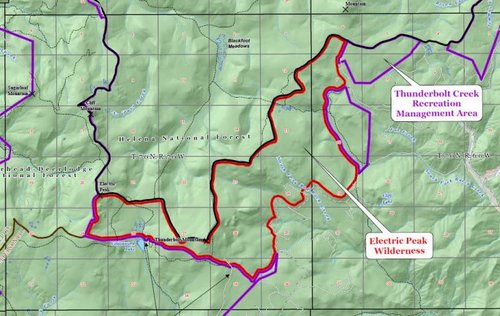Nameless Range
Well-known member
There are certain places in MT I think need greater protections, or at least an acknowledgement of their uniqueness as country and importance as habitat.
Over the years I've become obsessed with getting to know the Boulder Mountains.
In the Environmentalists Wet Dream, NREPA, two proposed wilderness exist within the range: The Electric Peak, and The Haystack.50,000 and 84,000 acres respectively. I am aware this will never happen.
Senator Tester's FJRA also proposes wilderness in the range, albeit one, in the form of the Electric Peak Wilderness. Which would only contain the south eastern slope of Electric Peak, and would be 4,900 acres in size.
In my opinion, 4,900 acres is a joke. New York's Central Park is just under 900.
I appreciate the protection and acknowledgement that it's needed and the permanence that comes with Wilderness. I've hunted smaller Wilderness Areas like the Welcome Creek, which you can hike from top to bottom in a few hours.
I understand a lot of FJRA and other Wilderness Bills are additions to existing Wilderness, but if a new isolated Wilderness Area is created, What do you think a reasonable minimum size should be? Or should we just take what we can get, and start looking at wilderness not as a place where you can take in large tracts of undeveloped country and roam, but rather as a placeholder for what will be small but permanent roadless areas?
Obviously, topography changes the nature of solitude, difficulty of traversing, etc. when it comes to large chunks of undeveloped land and what they can offer, but in my king-for-a-day world, my minimum would be 20,000 acres.
Over the years I've become obsessed with getting to know the Boulder Mountains.
In the Environmentalists Wet Dream, NREPA, two proposed wilderness exist within the range: The Electric Peak, and The Haystack.50,000 and 84,000 acres respectively. I am aware this will never happen.
Senator Tester's FJRA also proposes wilderness in the range, albeit one, in the form of the Electric Peak Wilderness. Which would only contain the south eastern slope of Electric Peak, and would be 4,900 acres in size.
In my opinion, 4,900 acres is a joke. New York's Central Park is just under 900.
I appreciate the protection and acknowledgement that it's needed and the permanence that comes with Wilderness. I've hunted smaller Wilderness Areas like the Welcome Creek, which you can hike from top to bottom in a few hours.
I understand a lot of FJRA and other Wilderness Bills are additions to existing Wilderness, but if a new isolated Wilderness Area is created, What do you think a reasonable minimum size should be? Or should we just take what we can get, and start looking at wilderness not as a place where you can take in large tracts of undeveloped country and roam, but rather as a placeholder for what will be small but permanent roadless areas?
Obviously, topography changes the nature of solitude, difficulty of traversing, etc. when it comes to large chunks of undeveloped land and what they can offer, but in my king-for-a-day world, my minimum would be 20,000 acres.





